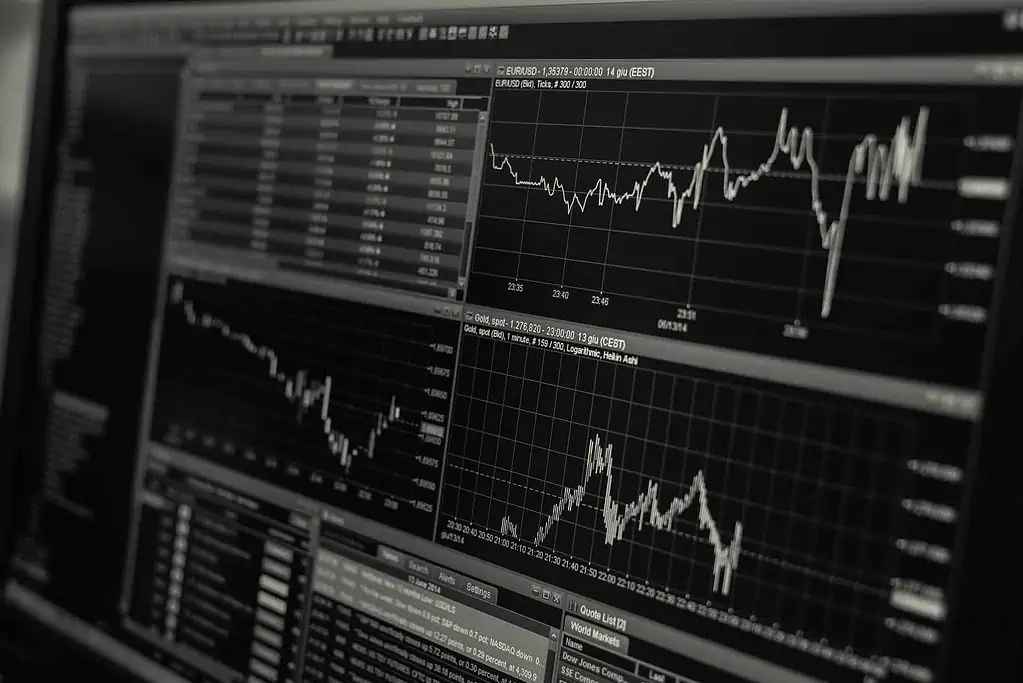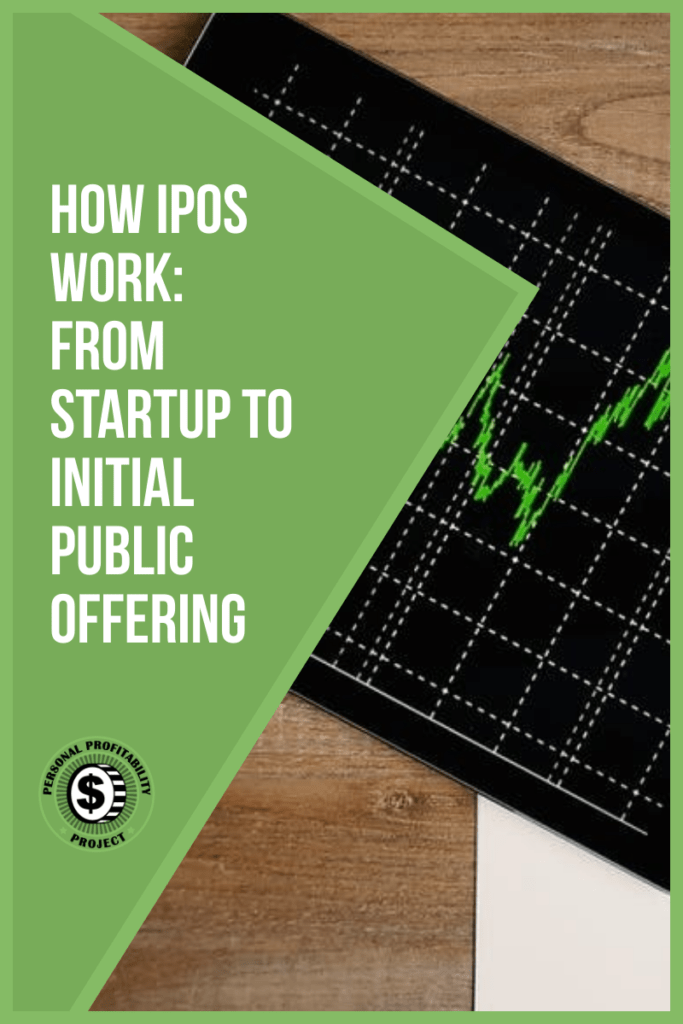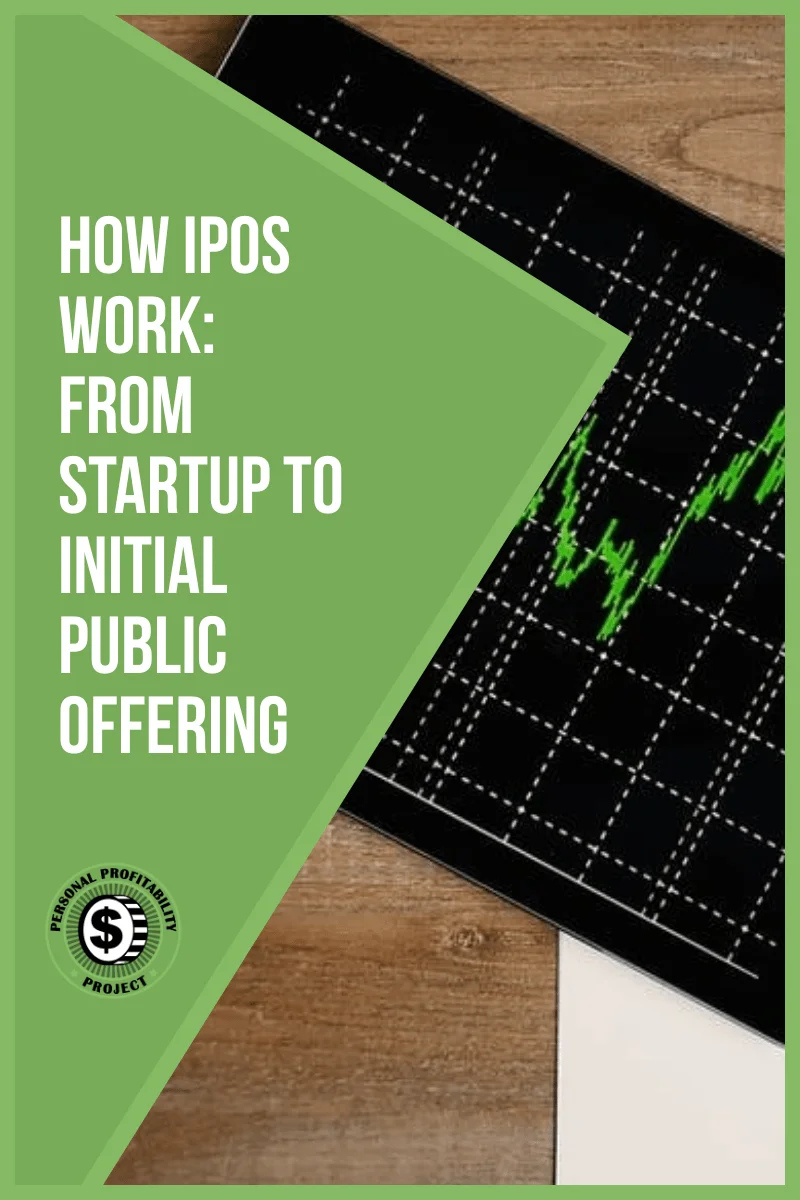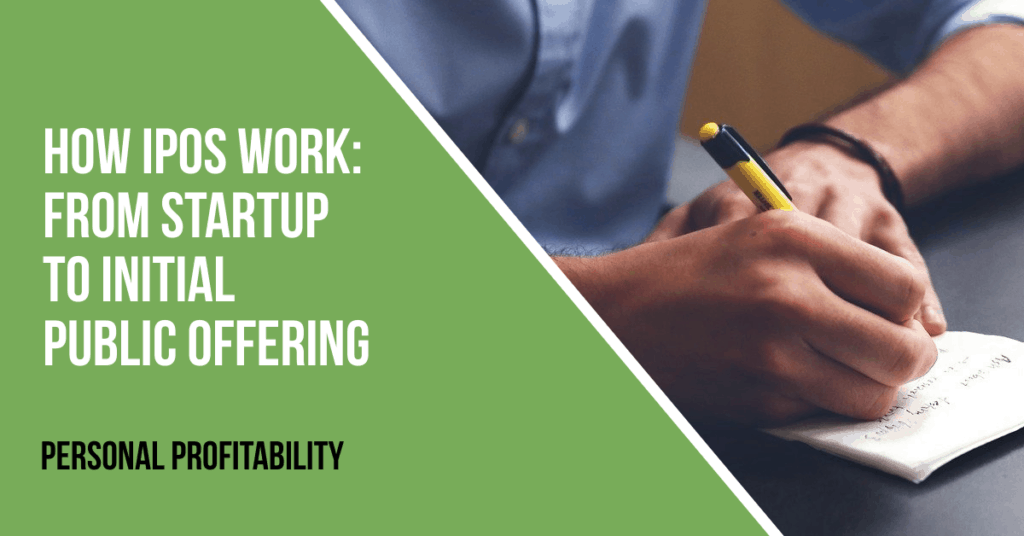There is little more exciting in business news than a big IPO or initial public offering. An IPO is a business process where shares of stock are first issued to the public on a major stock exchange. To typical investors like you and me, an IPO is a chance to earn a quick return on investment, but to investment banks, angel investors, venture capitalists, and company founders, IPOs are big business with billions of dollars on the line.

Startup Phase and Investor Funding
When a business begins, it generally starts as a “bootstrapped” company, or one paid for by a founder, or a small group of founders, who work on the business while earning virtually no income. They pay for the basic founding costs out of their own pockets, or from small investments from family and friends.
As the business grows, the company will eventually see revenue begin or fail right away. A commonly cited statistic says that about 90% of businesses fail within the first few years of starting and rarely make it through the stages of trying to generate their first profits.
Some companies, particularly in online and high tech industries, begin to show promise early on and can attract investments from wealthy individuals, known as angel investors, and specialized investment companies known as venture capital firms, or VCs.
When these investments take place, a company is given a valuation. This is the value of the assets of the company, fewer liabilities, plus the estimated current value of future earning power. The method for estimating these values can vary widely, and the inputs used to account for the valuation factors are usually just a very educated guess by people with experience valuing companies from time to time. This valuation is the first concrete step in determining a future stock price for the company’s IPO.
Pre-IPO Business Development and Growth
As an investor, you probably have not heard of most companies in this stage. But business owners are hard at work looking to increase the company value. A higher value means a higher IPO price, and ultimately more value for owners and investors.
As the company begins to grow, it is time to really focus on how the company is going to make money. Many growing companies are not immediately going to be profitable after receiving seed funding. This is why they needed funding in the first place. But this is when the viability of the idea and turning revenue into profits is going to start coming into focus.
As a growing business, this is the phase to use the prior round of funding to hire more employees, move into better office space, and grow the business to bring in more revenue, customers, and really market the business for future success. Many companies fail at this point, but success takes you one step closer to the coveted IPO.
Companies in this phase often exhaust their funding while paying a growing staff and investing in the business. Owners must look past angel investors for larger cash infusions. These most often come as funding rounds from larger investors such as venture capital funds.
Venture capital funds are large pools of money raised from a group of wealthy individuals or companies. Funds can range in size and purpose. Some funds will only invest in companies with $1 million or more in annual revenues. Others might only invest in companies with $10 million. Some invest only in product-based companies, while others only invest in online service businesses. Some have fewer rules, some have more rules.
This type of funding may come from one company or a group of companies as a funding round. This is usually called Series A funding, Series B funding, and so on for each round of investments. With each round of investments, the current owners and existing investors negotiate with the new investors to create an updated valuation for the company, usually much higher with each additional funding round.
With each investment, the company is expected to use the funds to spur further growth. Eventually, many companies will reach a point where management will decide to raise funds by selling shares to the general public. This step is called an initial public offering, or IPO.
The Steps for an IPO
IPOs are complex business processes. They involve existing owners and investors, outside advisors, underwriters, lawyers, and investment banks. Advisors, underwriters, and lawyers often charge tens of millions of dollars for their services, which are vital to bringing the shares to the public and bringing in a large capital infusion.
These are some of the important steps companies must follow to begin the IPO process.
- Engage Advisors – Advisors are investment bank teams with a specialty for taking companies public. They are commonly large, experienced investment banks such as Goldman Sachs, Morgan Stanley, or JP Morgan Chase. Advisors help the company establish an IPO valuation and help determine the number of shares sold and the IPO price.
- Hire Underwriters – Underwriters are also generally large investment banks. They are usually separate from the advisors due to a conflict of interest but usually come from the same group of companies. Underwriters take the biggest financial risk in issuing the new shares. The underwriters sell the new shares on the company’s behalf.
- Attract Investments – Companies hope that their IPO will be well subscribed by a variety of investors, but to ensure success owners might go on a “roadshow” to attract institutional investors, such as mutual fund managers, who can invest millions of dollars at once, as opposed to retail investors like you and me who generally only invest hundreds or thousands of dollars at a time.
- Determine Offering Amount – With the aid of advisors and earlier investors, the company will decide how much money to raise through the IPO. The largest IPO of all time was the Chinese online marketplace Alibaba, which raised $25 billion. IPOs are often in the billions but can be much smaller. The recent GoDaddy IPO brought in about $500 million to the company.
Setting Up an IPO for Success
What makes a successful IPO? The most common yardstick for success in raising the targeted capital while holding the share price even, or increasing it, after the shares go on sale. This is a harder task than it might sound, which is why companies pay so much to their advisors and underwriters.
In order for a company to raise billions of dollars, it needs to find investors willing to pay billions of dollars for the company shares. Some companies have millions of shares, while others may have hundreds of millions. There is no right or wrong number of shares. It just depends on how the company was initially founded and received investments along the way.
Contrary to a popular misconception, a company’s share price is not the main driver of its value. The metric to look for is market capitalization, often shortened to “market cap” by experienced investors. The market capitalization is the total number of shares times the stock price. A company with 10 million shares worth $5 would be valued at $50 million. A company with 5 million shares trading at $10 is also worth $50 million. There is no difference, even though one company’s shares are traded at twice the price of the other.
In the months leading up to the IPO, the investment bankers are hard at work determining the company’s value, or market capitalization, to raise as much money as possible for their client without having the stock price fall in the days, weeks, and months following the IPO.
There are many methods used to determine a company’s value at this stage, which is much more formal and data-driven than in the early funding stages. At this point, the bankers are using complex valuation models taking into account these very important factors, in addition to many proprietary models developed by the bank itself. These two tools are referred to as “fundamental analysis,” as the values are derived based on the company’s fundamental financial performance.
Discounted Cash Flow Analysis – A DCF model is one of the most important tools finance professionals have to value a company. The DCF model projects future revenue and expenses to determine a projected free cash flow, which is the cash the business generates that can be used to either reinvest in the company, save for the future or pay a dividend to investors. Banks then apply a formula taking into account the risk of future failure to create a current value of future cash flows, which is a proxy of the company value.
Multiple Analysis – When you look at a company’s financial performance indicators, you will see many ratios used that, on their own, tell us as investors information such as the risk of default on debt obligations, the value of assets, and returns on invested capital. Investment bankers and analysts use the IPO company’s ratios compared to other companies in the same industry to help estimate the value compared to the company’s peers.
Once the company value has been established, the bankers have the total market capitalization. Based on their best estimate for investor demand, they will determine the portion of the company be sold in the IPO, which can come from current owners and investors as well as raising funds from an increase over prior valuations.
Splitting Up the Proceeds
When the company shares go live on the market, a certain percentage of ownership is made available to the public. Similar to prior funding rounds, existing owners will maintain their level of ownership in the company unless they sell a portion of their shares with the IPO, which is a very common practice. Ownership can be diluted by issuing new shares, but this is more common well after the IPO.
The issue with existing investors selling their shares is that if all owners sell their shares at the same time, the market will be flooded with shares and the price will fall. Large investors risked their money in the company to turn a profit, and most want to sell at a point early on to “exit” their investment and turn their shares into big profits to pad their bank accounts. Large early investors usually agree on a contracted date when they can begin selling shares sometime after the IPO.
With the assistance of advisors and underwriters, the existing founders and investors can determine a safe number of shares to sell from their own holdings at the time of the IPO. If they sell with the IPO and the price increases after, they lost out on potential profits. If they hold and the price falls, their profit falls with it.
There is no rule on how to split out the shares sold in the IPO. It is a crucial negotiation that must be considered by all existing owners to ensure everyone does not lose their investment from one bad move.
Pre-IPO Public Communications
Before the IPO, the company going public is required by law to disclose certain financial information. This information comes in the form of a prospectus. It includes the main financial statements, plus additional information on company risks, and very extensive notes explaining the items in the financial statements.
The core financial statements are:
- Balance Sheet – This statement includes a snapshot of company assets, liabilities, and shareholder equity.
- Income Statement – This statement contains profitability figures for a period of time. Revenue, cost of goods sold, SG&A (sales, general, and administration) expenses, income taxes, and interest paid to make up the majority of this statement.
- Statement of Cash Flows – This statement shows cash inflows and outflows from both company performance and internal and external investments.
The company also provides the number of shares outstanding and a projected IPO share price. Outside financial analysts use this information to make their own estimate of the company’s intrinsic value to decide whether to invest. Individual investors can do the same but usually use fewer complex models.
As the IPO gets closer, the company provides a target IPO share price range. Just before the IPO, the final IPO share price is set based on investor demand and the company’s estimated market capitalization.

Signing Up for an IPO
Generally, IPOs are limited to institutional investors and very wealthy investors with preferred status from their brokerage. Depending on demand, an IPO may be oversubscribed. In this case, everyone who wants IPO shares cannot get them but has to wait until they go on sale, usually at a higher market price than the IPO price.
If you are a wealthy investor or have access to the IPO from other means, you can subscribe for a certain number of shares. Most major stock brokerage firms are given an allotment of shares and can decide how to allocate them to their investors who subscribe. This can be based on how valued the client is to the firm, the order investors sign up, or an even allocation by percentage to the investors who sign up.
If you are able to sign up, you might not get all of the shares you ask for, but you have to fund your account with cash ahead of time to get your shares as requested.
IPO Day
On the day of the IPO, all of the money and shares move between the investors, underwriters, and the company. At the time of the IPO, which is usually at the opening of the market for the day, the cash moves from the investors through their brokers to the underwriters. The shares are distributed from the underwriters to the brokers and onto their clients. After the IPO, the underwriters send the cash proceeds to the company.
From that point on, the shares can be bought and sold on the secondary markets. The most popular markets in the United States are the New York Stock Exchange and the NASDAQ. The shares are only bought and sold on the specific market where the shares are listed, though sometimes very large deals can be negotiated at a specific price outside of the market price.
Investors looking to buy can enter an offer price and shareholders looking to sell can enter a selling price. When the two prices meet, the shares trade and that price is the new published share price. Multiply that by the number of shares and you have the new market capitalization.
In some instances, there are problems on the IPO day, such as the infamous Facebook IPO on the NASDAQ. With this IPO, a technical glitch prevented shares from trading as expected. In this case, trading was delayed until later in the day and some trades failed to execute, costing large investors millions of dollars.
Add On Sales
In some cases, an IPO is so successful that the company decides to offer a second public stock offering, called an add-on or secondary offering, several days or weeks after the IPO. The fund’s transfer process works similar to the IPO but adds more shares of stock to the secondary market.
Remember that the number of shares is fixed before the IPO. Any add-on does not change the number of shares outstanding, it just transfers them from the company, investor, or founder ownership to the public. The only time the number of shares changes after the IPO is with a split or a reverse split.
Operating as a Publicly Traded Company
At this point, the company is a public company and must follow all rules and regulations for public companies. For companies listed on United States exchanges, namely the New York Stock Exchange or NASDAQ, the companies are required to follow GAAP, Generally Accepted Accounting Principles, and publish regular financial statements.
The most important statements to investors are the 10-K, an annual financial report, and the 10-Q, a quarterly financial report. The company must also publicly report material stock purchases and sales by company executives and board members and executive compensation summaries.
The company should be using the invested dollars to help grow the business, as a higher market capitalization leads to a higher stock price, and the executives work for the company shareholders, who are represented by the elected board of directors.
What This Means for You
As an individual investor, most IPOs are going to be out of reach unless you qualify as an accredited investor. Accredited investor requirements can be set at the state level, but follow the guidance of the Securities and Exchange Commission, SEC.
In general, to participate in an IPO, you must have a high income or high net worth. However, some stockbrokers, such as Loyal3, allow investors to buy in without accreditation at a lower investment level. In some cases, companies can make an effort to include more investors as well. A recent example is Lending Club, which invited its investors to participate in the IPO without being a super-wealthy investors invited by their stockbroker.
If you want to buy into an IPO, visit your preferred brokerage website and look up the IPO requirements. Another option is to look to brokers like Loyal3 where you can join in an IPO without accreditation.
Typically IPOs see a stock price increase of 20% or more on the first day of trading, sometimes doubling or more. Even without tens of thousands of dollars to invest, that is something all investors can get on board with.
However, before you join in, understand the risks of investing in individual stocks and IPOs. Accreditation requirements exist to protect small investors from losing money they can’t afford in the stock market. Anything you invest in an IPO should be money you can afford to lose. While we all hope our investments will grow, only time will tell how successful our investments will be.
If you are comfortable with the IPO process, visit your stockbroker and watch finance news to see which IPOs are coming soon. Your big investment payday may be coming soon.

This post was originally published on June 25, 2015, and updated on March 31, 2022.


